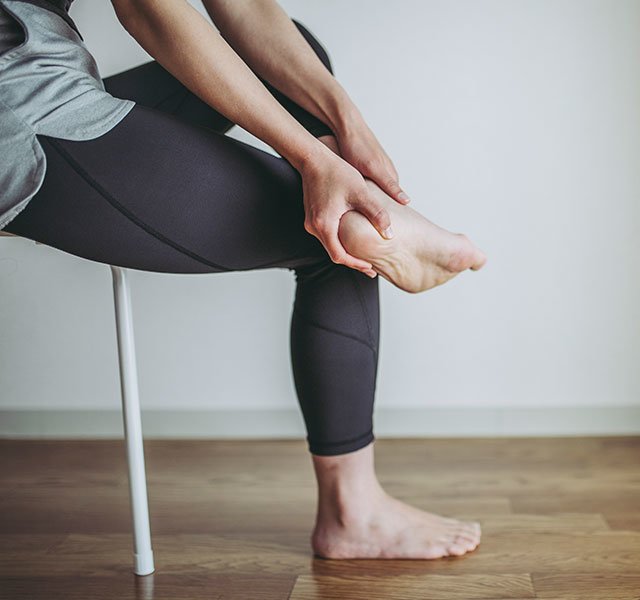When it comes to foot pain, plantar fasciitis is a key culprit. With plantar fasciitis, the thick band of tissue that connects your heel to your toes (the plantar fascia) becomes inflamed. Plantar fascia helps absorb shock and supports the arch of your foot as you walk — and it can become tight if it's not sufficiently stretched.
"When the calf muscle becomes too tight, it acts as a pulley system around the heel that causes a stretching of the plantar fascia," explains Nicole Brouyette, DPM, a podiatrist at Henry Ford Health. "Over time, that tightness leads to small micro-tears at the heel, which can be shockingly painful."
What Is Plantar Fasciitis?
Your plantar fascia ligaments endure significant daily wear and tear. Too much pressure can damage and tear them. The resulting inflammation can cause heel pain and stiffness.
Plantar fasciitis often produces pain that's particularly unbearable with your first morning steps. The pain usually eases as you move around throughout the day, but it can also return after long periods of standing or activity — or when you get up after an extended period of sitting.
"A lot of people come into the office complaining of generalized heel pain," Dr. Brouyette says. "While they might have developed a heel spur because of the plantar fasciitis, it's the small inflamed microtears in the plantar fascia that cause the pain, not the spur."
The pain from plantar fasciitis develops gradually over time. Some people describe a dull or burning ache while others complain of stabbing pain across the bottom of their foot.
Who Is At Risk Of Developing Plantar Fasciitis?
Plantar fasciitis doesn't have one specific cause. Instead, a constellation of characteristics and activities can increase your risk of developing the condition.
Risk factors include:
- Age: The risk of plantar fasciitis increases with age, up to age 70. "We usually don't see plantar fasciitis in people under 40," Dr. Brouyette says. A key exception: Pregnant women. Pregnancy can put a lot of pressure on the ligaments that make up the plantar fascia.
- Weight: You have a higher risk of developing plantar fasciitis if you're overweight or obese. Weight increases pressure on the plantar fascia, which can lead to inflammation. Sudden weight gain can be especially problematic (as in pregnancy).
- Activities: Plantar fasciitis is more common among people who do activities that place a lot of pressure on the bottom of the foot, like long-distance running, dancing and standing for extended periods of time (factory workers, teachers and restaurant servers may be especially vulnerable).
- Foot mechanics: If you have high arches, flat feet or tight Achilles tendons (which attach your calf muscles to your heels), you may also have an increased risk of developing plantar fasciitis. Just going barefoot or wearing shoes with soft soles and poor support (like slippers) can lead to plantar fasciitis.
How Do You Treat Plantar Fasciitis?
At-home treatment, including lifestyle changes and stretching exercises, is usually the first line of defense against plantar fasciitis. Pain-reduction strategies include:
- Rest
- Ice
- Anti-inflammatory medications
- Arch support and shoe accommodations (such as orthotic inserts)
If home treatments don't produce relief, your doctor may stretch out the calf muscle in the office and recommend corticosteroid injections directly into the damaged portion of the plantar fascia.
"These injections are usually mixed with an anesthetic to help dull the pain," Dr. Brouyette says. "The idea is to provide temporary relief so you can do exercises at home. Unfortunately, plantar fasciitis isn't just something we can fix in the office. You have to do your part at home, too, with stretching exercises. Otherwise, the plantar fasciitis will recur."
Putting Your Best Foot Forward
As with most things, the best treatment for plantar fasciitis is prevention. You can take proactive steps to keep plantar fasciitis at bay, including:
- Wearing supportive shoes
- Staying active
- Stretching daily
Unfortunately, ignoring plantar fasciitis isn't the best way forward. The condition tends to worsen over time and can prevent you from participating in activities you enjoy. Altering how you walk to relieve pain and pressure isn't a good solution; it can lead to foot, knee, hip or back problems down the line.
Suffering from foot pain? Talk to your doctor or podiatrist. "A healthcare professional can point you in the right direction and recommend supportive shoes, exercises, even a prescription for physical therapy to help relieve pain and get you moving again," Dr. Brouyette says.
To find a doctor or podiatrist at Henry Ford, visit henryford.com or call 1-800-436-7936.
Dr. Nicole Brouyette is a foot and ankle surgeon who sees patients for podiatric needs at Henry Ford Hospital — Detroit, Henry Ford Medical Center — Fairlane and Henry Ford Medical Center – Pierson Clinic.



